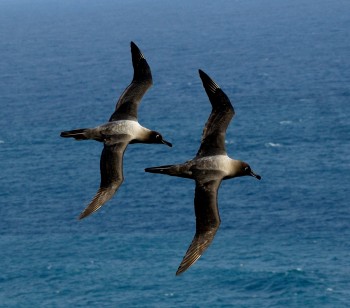Mark Cocker (author) and David Tipling (photographer) have produced a remarkable book between them. Birds & People considers the 200 or so bird families of the World in nearly 600 pages, giving each a lavish, well-illustrated account. The approach, unique to my knowledge (and I was once in charge of the University of Cape Town’s Niven Library, one of the World’s great ornithological collections and surely the most comprehensive in the Southern Hemisphere) is to “explore the common ground where [humans and birds] meet”. The Introduction gives the clue. “It is about how people’s lives are entwined with, and are often shaped by, their encounters with birds”.
With so many families to cover, how does the book treat the families within the tubenose order Procellariiformes, the albatrosses, petrels and their kin? Quite well: the albatross family Diomedeidae gets six pages. One of these is a beautiful full-page photograph of an ACAP-listed and Near Threatened Light-mantled Albatross Phoebetria palpebrata in flight; I had to look at it twice to see it was not a painting. The text considers how the albatrosses got their name: a complicated descendant from the Arabic for water-carrier via the Spanish for a pelican with its large pouch.
Samuel Taylor Coleridge’s The Rime of the Ancient Mariner gets a detailed treatment. Coleridge was friends with fellow-poet William Wordsworth and it may be that Wordsworth when suggesting bringing an albatross into the poem, lent Coleridge a sea captain’s book that he owned - in which the shooting of a “disconsolate black Albitross” in the “Great South Sea” in the hope of gaining a fair wind is described. So, was Coleridge’s albatross a Phoebetria sooty?

Light-mantled Sooty Albatrosses fly in unison
Photograph by Aleks Terauds
The second half of the albatross account deals mainly with the modern at-sea mortality from fishing, especially long-lining. Cocker writes: [p]erhaps by managing somehow to organize ourselves, and to redesign our fisheries to shorten the odds for survival of the world’s albatrosses, we can simultaneously redeem some of the long dreary past in our relations with these remarkable and charismatic sea creatures.” This could stand to describe pretty closely what the Agreement on the Conservation of Albatrosses and Petrels is attempting to do.
The petrel and shearwater family Procellariidae (five pages), storm petrels Hydrobatidae (three pages) and diving petrels Pelecanoididae (only a third of page) follow to complete the tubenose coverage. The seemingly supernatural night-time calls of Endangered Bermuda Petrels or Cahows Pterodroma cahow were “so unnerving to Spanish sailors that they refused to settle such a haunted landscape”. Cocker wonders if this had anything to do with another myth: that of the Bermuda Triangle as a “zone of occult mystery and nautical mishap”. There is also a good account of the historical exploitation (I consider “harvesting” in this context to be a weasel word and so refuse to use it) of Cory’s Shearwaters Calonectris borealis in Madeira. One had to bite the chick’s neck to kill it and the plucked feathers ended up stuffing English eiderdowns!
I was pleased to see the recently rediscovered and Critically Endangered New Zealand Storm Petrel Oceanites maorianus featured (and illustrated) not only as a good-news story but because I well remember risking sea sickness in 2010 to see several behind our bobbing vessel in the Hauraki Gulf.
This is book to dip into, perhaps to read in the evening the account of a family for which you have that day seen a member. I shall take all 2.5 kg of it with me on my next voyage into the Southern Ocean and expect it to help while away many a happy hour when the Roaring Forties keep me bunk-bound.
Reference:
Cocker, Mark & Tipling, David 2013. Birds & People. London: Jonathan Cape. 592 pp. ISBN 9780224081740. GBP 40.00. http://www.vintage-books.co.uk/books/0224081748/mark-cocker/birds-and-people/.
John Cooper, ACAP Information Officer, 28 December 2013

 English
English  Français
Français  Español
Español